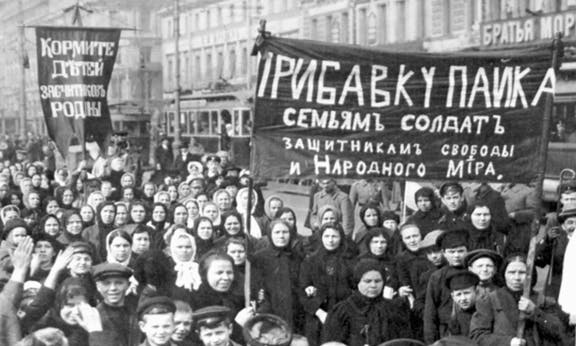An International Women’s Day to remember

International Women’s Day hasn’t always been about corporate lunches and worthy pontificating by stuffy politicians. One hundred years ago, it started a revolution. Not a revolution in anti-ageing cream or stain remover like the sort we’re used to, but a generalised uprising of workers and the oppressed against their rulers.
The revolution of February 1917 in Russia brought an abrupt end to the tsarist regime that had ruled Russia for more than three centuries. It also established the most advanced form of working class democracy yet seen.
The fact that the revolution was started by women surprised almost everyone. Prior to World War One, women had been a relatively backward social layer in Russia. The war changed this. It drew women into the workforce in large numbers to replace the millions of Russian men sent to fight and die, exposing them to the indignities but also the potential power of the workplace. By 1917, women made up as much as half of the workforce in some Russian cities.
The war impacted on women in other ways. Soldiers’ wives and widows were condemned to extreme poverty as the government that had used their husbands as cannon fodder refused to provide adequate support. Shortages and rationing meant that women struggled to provide for themselves and their children, while they saw no corresponding sacrifices being made by the elite.
Partly because they were not as accustomed to such conditions as were the more established sections of the Russian working class, women workers reached their breaking point more rapidly. And when they did, they proved capable not only of organising themselves, but of leading wider layers of society.
The occasion was International Women’s Day, an annual event initiated by the socialist movement to commemorate a heroic strike by garment workers in New York City in 1908. Not content to confine their message to a routine display of grievances, women workers used the day to mobilise wider layers of workers to confront their oppressors and demand thoroughgoing social change. They set out to transform social conditions. To do this, they had to win others to their cause.
Historians Jane McDermid and Anna Hillyar describe how the day unfolded:
“It was not women in the queues for bread and fuel who began the street protests, but female textile workers from a number of plants in the Vyborg district of Petrograd. They downed tools collectively, left the mills and moved speedily and deliberately in large groups from one factory to another.
“They did not restrict their search for allies to the textile sector. They demanded from workers in other industries, and notably the metal industry which was regarded as in the vanguard of the labour movement, not just moral support, but active participation.
“At each stop, the women would cajole and insist that now was the time to cease working and show the employers and government that workers had finally had as much as they were prepared to take. The women rammed home their points by throwing whatever they could lay their hands on (stones, snowballs, sticks) at factory windows and doors, and invading the buildings. Their methods were persuasive enough to convince masses of workers that this was not a simple bread riot, as so many politicians were assuming, but something much wider in scope.”
This movement would go on not only to overthrow the tsar but also to create organs of democratic workers’ control that challenged the entire capitalist system and in so doing won massive gains for women before the revolution was eventually destroyed by Stalin.
One hundred years later, the world is a very different place. Women are a much more established part of the workforce and hard-fought gains won through many years of struggle mean there are far more women walking the corridors of power than there were in 1917.
But some things remain the same: women continue to be concentrated in low paid and less secure jobs and industries. They continue to bear the brunt of the essential unpaid caring work required to keep capitalism functioning efficiently. They are still denied full control over their reproductive health. And they continue to face demeaning sexist treatment and discrimination in their everyday lives.
Just like one hundred years ago, these grievances continue to be felt through the impact of capitalist crisis and war: the global financial crisis, declines in wages and cuts to social services have all had a disproportionate effect on working class women. Now as then, the experience of women’s oppression is shaped by the broader social context, and the rise and fall of wider class conflict.
The ascendancy of Donald Trump, who spews the sort of unchecked bigotry that the rich and powerful usually keep behind closed doors, has proved for many to be the last straw and an important focus for renewed resistance.
The massive women’s marches in the US on 22 January – the largest anti-sexist marches in world history – have been the most important demonstrations of mass opposition to the Trump administration so far. Hopefully, they mark the beginning of an ongoing movement that can confront not only Trump but also the system that has given us his vile administration. Women are again taking to the streets against Trump on 8 March, International Women’s Day.
The 1917 Russian revolution demonstrates that the action of one section of the population can be an important catalyst for drawing wider layers into action. A century later, women are once again taking the lead against capitalist tyranny and social injustice.
Now, as then, our goal should be to build from this a movement that can bring together and champion the cause of all those oppressed and exploited by this rotten system.